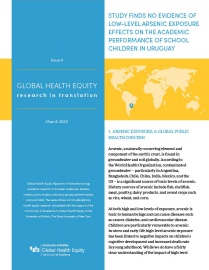Issue 6
Study Finds No Evidence of Low-Level Arsenic Exposure Effects On the Academic Performance of School Children in Uruguay
Global Health Equity Research in Translation brings academic research to broader audiences: decision makers, policy makers, advocacy groups, philanthropists, and journalists. The series draws on transdisciplinary health equity research completed with the support of the Community of Excellence in Global Health Equity at the University at Buffalo, The State University of New York.
The 6th Issue of the Global Health Equity Research in Translation Series explores Dr. Gauri Desai’s scholarship around low-level arsenic exposure. To date, only two studies look at arsenic exposures impact on academic achievement. However, they focus on areas with high exposure. Dr. Desai’s study in Uruguay measures the impact of low-level exposures – perhaps an exposure that affects about half the world’s population.
I. ARSENIC EXPOSURE: A GLOBAL PUBLIC HEALTH CONCERN
Arsenic, a naturally-occurring element and component of the earth’s crust, is found in groundwater and soil globally. According to the World Health Organization, contaminated groundwater – particularly in Argentina, Bangladesh, Chile, China, India, Mexico, and the US – is a significant source of toxic-levels of arsenic. Dietary sources of arsenic include fish, shellfish, meat, poultry, dairy products, and cereal crops such as rice, wheat, and corn.
At both high and low levels of exposure, arsenic is toxic to human beings and can cause diseases such as cancer, diabetes, and cardiovascular disease. Children are particularly vulnerable to arsenic: in utero and early life high-level arsenic exposure has been linked to negative impacts on children’s cognitive development and increased death rate in young adulthood. While we do have a fairly clear understanding of the impact of high-level arsenic exposure on general cognitive ability (IQ), children’s school achievement is arguably of greater importance from a public health perspective, as it requires the deployment of social skills in peer-teacher interactions; necessitates behavioral self-regulation; and is predicated on the utilization of several discrete cognitive domains, all of which are required for children to grow into functional, independent adults.
To date, there are only two studies that look at the impact of arsenic exposure on the academic achievement of school children, and both are conducted in areas that have high levels of exposure. Although these studies show no associations between exposure and achievement, two studies are insufficient to conclusively demonstrate that arsenic exposure does not affect scholastic achievement. As such, the association between arsenic and achievement at high levels warrants further study.
An even more crucial gap in the research has been the impact of low-level arsenic exposure on children’s neurobehavioral outcomes, including academic achievement. Why? Although we don't know the exact number, by some estimates about half of the world’s population is exposed to low levels of arsenic. The other half is split among the following categories: medium exposure levels, high exposure levels, extremely high exposure levels, and no data available. Thus, low exposure is the single most prevalent exposure to arsenic in the world. Because the arsenic-achievement association is not yet well understood due to the paucity of research to date, it is important to pursue this line of inquiry in general. Further, because the majority of the world is exposed to low (rather than high) levels of arsenic, it is crucial to study arsenic-achievement associations at low levels of exposure as the existence of even small effects would affect greater numbers of people.
With her colleagues, epidemiologist Dr. Gauri Desai addressed this research gap at a study site in Montevideo, Uruguay, which has longstanding and well-documented problems with toxic metal exposures including lead and arsenic. Desai and her colleagues investigated the impact of low-level arsenic exposure on children’s academic achievement, and checked to see if intake of folate and vitamin B-12, as well as their levels in serum, could modify the effect of low-level arsenic exposure on the academic achievement of children.
The study found little evidence that low-level exposure to arsenic affects the academic achievement efforts of children attending the first grade of elementary school. Further, the study found no impact of vitamin-B intake, status (the amount of B-vitamin that remains in the blood serum after the metabolism has begun), or methylation (the process by which the body processes and removes arsenic) on the academic achievement of children with low-level arsenic exposure.
II. PRACTICAL TAKEAWAYS
- Additional studies in other settings with low-level arsenic exposure are needed to confirm findings on children’s school achievement.
- Longitudinal data would help assess if longer-term neurobehavioral impacts are observed with lower-level arsenic exposure.
III. POLICY TAKEAWAYS
- While there was no evidence that low-level exposure to arsenic affects academic achievement in first grade, more evidence is required before surmising that educational interventions for children with low-level environmental arsenic exposure are unwarranted.
- Based on current evidence, the intake of folate and vitamin B-12 does not modify any associations between low-level arsenic exposure and academic achievement. However, more research is required before policy recommendations can be made about nutrient supplementation interventions.
ACKNOWLEDGEMENTS
The information in this policy brief was extracted from research originally published in International Journal of Hygiene and Environmental Health.
AUTHORS
Dr. Lisa Vahapoğlu and Dr. Gauri Desai
RECOMMENDED CITATION
Vahapoğlu, Lisa and Desai, Gauri. “Study Finds No Evidence of Low-level Arsenic Exposure Effects on the Academic Performance of School Children in Uruguay.” Global Health Equity Research in Translation. Eds. Frimpong Boamah, Kordas, and Raja. Community of Excellence in Global Health Equity, March 2020.
ORIGINAL RESEARCH
Desai, G, Barg, G, Vahter, M, Queirolo, E, Peregalli, F, Mañay, N, Millen, AE, Yu, J, Browne, RW, and Kordas, K. “Low level arsenic exposure, B-vitamins, and achievement among Uruguayan school children,” International Journal of Hygiene and Environmental Health. January 2020; 223: 1.
SERIES EDITORS
Dr. Emmanuel Frimpong Boamah, Dr. Katarzyna Kordas, and Dr. Samina Raja
DESIGN AND PRODUCTION
Nicole Little and Jessica Scates

